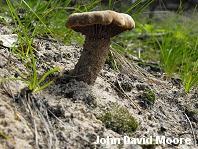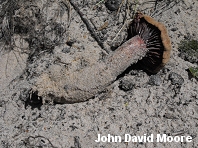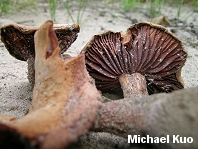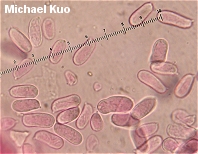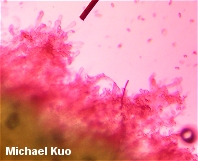| Major Groups > Gilled Mushrooms > Pale-Spored > Laccaria > Laccaria trullissata |

|
Laccaria trullissata [ Basidiomycetes > Agaricales > Hydnangiaceae > Laccaria . . . ] by Michael Kuo This interesting species of Laccaria can be found in sand dunes on the East Coast, the Gulf Coast, and along the Great Lakes. Its habitat and its thick, purple gills distinguish it from just about anything else--though if you are in eastern Canada, the similar sand-loving Laccaria maritima can only be reliably separated with a microscope (details below). Laccaria maritima has whitish basal mycelium, and spores with the spiny ornamentation typical of the genus; it is recorded from the East Coast of Canada. Description: Ecology: Mycorrhizal, usually with pines (Pinus species); growing scattered or gregariously in sand dunes; late summer and fall; on the East Coast, the Gulf Coast, and along the Great Lakes. Cap: 2-7 cm; convex, becoming flat and sometimes depressed; the margin often inrolled, not lined; finely hairy to finely scaly or more prominently roughened; purplish when young but soon reddish brown, brownish, or buff. Gills: Attached to the stem; close or nearly distant; dark purple. Stem: 4-9 cm long; up to about 2.5 cm thick; usually with an enlarged base; hairy and often longitudinally lined; the surface frequently splitting near the apex; colored like the cap; with purplish basal mycelium that you are unlikely to see beneath the covering of sand; often nearly entirely submerged in the sand. Flesh: Pale purplish or whitish. Odor and Taste: Not distinctive. Spore Print: White. Microscopic Features: Spores 14-20 x 5.5-8 µ; elliptical or broadly spindle-shaped; roughened, but without the clearly defined, measurable spines typical of Laccaria species; inamyloid. Basidia 4-spored. Cheilocystidia absent or rare; when present filamentous. Pileipellis a cutis of elements 5-10 µ wide, with scattered bundles of upright elements; terminal cells subclavate to capitate. REFERENCES: (Ellis, 1874) Peck, 1912. (Saccardo, 1887; Smith, Smith & Weber, 1979; Weber & Smith, 1985; Lincoff, 1992; Mueller, 1997; Barron, 1999; Miller & Miller, 2006.) Herb. Kuo 09110411. This site contains no information about the edibility or toxicity of mushrooms. |
© MushroomExpert.Com |
|
Cite this page as: Kuo, M. (2010, December). Laccaria trullissata. Retrieved from the MushroomExpert.Com Web site: http://www.mushroomexpert.com/laccaria_trullissata.html |
